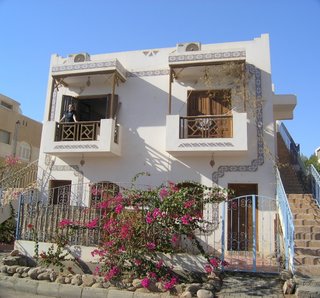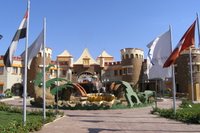Christmas in Aswan - Wind and Water
 No longer having to rely on the ‘inundation’, this is all made possible by the High Dam, south of Aswan. Completed in 1970, it created the second largest reservoir in the world; Lake Nasser, which today provides Egypt with 85% of it’s energy, having drowned the entire Nubian homeland (bad luck, guys) in the process. Under the waters of Lake Nasser are the remains of human occupation dating back to the dawn of modern man, which was only properly understood by archaeologists in recent times. The lovely Nubian museum in Aswan displays a representation of what must still be down there, the story of civilisation. Also on the list of artefacts to be inundated, sacrificed to the gods of the modern world, were the Temple of Isis (the most powerful stronghold of the cult, and the last to resist the tide of Christianity, which held out here for a while before Salah al-Din sorted them out) and Abu Simbal, built by Rameses II to honour himself and fill his subjects and enemies with awe.
No longer having to rely on the ‘inundation’, this is all made possible by the High Dam, south of Aswan. Completed in 1970, it created the second largest reservoir in the world; Lake Nasser, which today provides Egypt with 85% of it’s energy, having drowned the entire Nubian homeland (bad luck, guys) in the process. Under the waters of Lake Nasser are the remains of human occupation dating back to the dawn of modern man, which was only properly understood by archaeologists in recent times. The lovely Nubian museum in Aswan displays a representation of what must still be down there, the story of civilisation. Also on the list of artefacts to be inundated, sacrificed to the gods of the modern world, were the Temple of Isis (the most powerful stronghold of the cult, and the last to resist the tide of Christianity, which held out here for a while before Salah al-Din sorted them out) and Abu Simbal, built by Rameses II to honour himself and fill his subjects and enemies with awe. Four gargantuan statues of this megalomaniac guard the entrance, which is flanked by friezes of slaves, Nubian and Assyrian, roped together by the neck and crawling in obeisance.
Four gargantuan statues of this megalomaniac guard the entrance, which is flanked by friezes of slaves, Nubian and Assyrian, roped together by the neck and crawling in obeisance. Both of these were saved by a massive international effort headed by UNESCO, being cut into huge pieces and moved to higher sites at enormous cost. What else was inundated will remain forever a silent mystery. It is an impossible conundrum trying to decide on the rights and wrongs of this so, after scratching our heads and frowning a lot, we’ve decided that we don’t know what to think! We also don’t know what to think about the armed tourist police and army who have a high profile everywhere and escort tourist convoys to remote sights. Is this a token gesture to the international community, showing that Egypt takes security seriously, or just part of a military controlled state? It seems that Egyptians enjoy religious but not political freedom.
Both of these were saved by a massive international effort headed by UNESCO, being cut into huge pieces and moved to higher sites at enormous cost. What else was inundated will remain forever a silent mystery. It is an impossible conundrum trying to decide on the rights and wrongs of this so, after scratching our heads and frowning a lot, we’ve decided that we don’t know what to think! We also don’t know what to think about the armed tourist police and army who have a high profile everywhere and escort tourist convoys to remote sights. Is this a token gesture to the international community, showing that Egypt takes security seriously, or just part of a military controlled state? It seems that Egyptians enjoy religious but not political freedom. We arrive in Aswan, a bustling town in the far south of Egypt, almost on the border with Sudan and once fashionable winter resort for rich Europeans who travelled here courtesy of Thomas Cook, the first tour operator. The Aga Khan (who was weighed in jewels for his diamond jubilee in 1945) had a palace here where he spent his winters with his beautiful wife, a former Miss France. He also built a beautiful mausoleum, far bigger than the palace and it is said that, before she joined him there, the Begum put a fresh red rose on his grave every day and, on six successive days, when there were none to be found in Egypt, she had them flown in from Paris!
Bewitched by the silver tongue of Dominic, a lovely Irishman who has lived and taught in Cairo for the last couple of years, we find ourselves having our Christmas Dinner treat (omelette and salad) in the New Cataract Hotel (£6 each), our first non-Egyptian food for half a lifetime! This is the back door into the Old Cataract Hotel: the place to be in the 20’s, after dinner we wandered secretly through the rarefied and serene bubble of its gardens – Ahhh. The bubble is not burst, however as our hotel room has a BATH! For Christmas Basil bought me a bottle of bubble bath, and I wallowed in unimagined luxury, indulging in reading ‘Death on the Nile’ by Agatha Christie, the beginning of which is set in the Old Cataract Hotel (it’s funny what becomes a luxury, to be anticipated and savoured, when you’re travelling!).
Since then Egypt has shivered in a state of shock at the freak low temperatures it has been experiencing (down to 4o at night) along with high winds in this area. It is the only topic of conversation, people shake their heads and suck their teeth – ‘Very cold! Warmer soon, Insh Allah!’ We covered ourselves with more and more blankets until, Eureka! Hot-water-bottles! Fill your empty water bottles with very hot water and Bob’s yer uncle! The Egyptians think we’re mad (‘In Egypt we never do that’) but we’re the only warm people in Aswan at night! As a result of this cold, as well as a sandstorm, we postponed our planned trip (3 days and 2 nights) in a felucca (traditional Nile sailing boat) downriver to Luxor, until next Monday and are hoping the weather will turn more clement by then.
Meanwhile, there is lots to see and do here: we have spent a tranquil day in the charmed oasis of Kitchener Island, gifted to him for heroic deeds and where he indulged his passion for exotic plants from all over the Empire; been driven half-demented by wretched tourist hustlers, trying to sell you their wares (tourism has dropped away recently, a result, I suspect, of the media hype against all things Moslem); philosophised over countless cups of tea in the back of their shops with genuinely friendly people (who more than make up for the hustlers); wandered, invisible (they don’t hassle you at all, or even speak to you), through the Nubian village on Elephantine Island;
wobbled hither and thither on hired bicycles (much to the amusement of the locals!); met a flamboyant, gold-toothed Arab who produced a shenai from the folds of his five layers of djeleba and told us of his travels all over the world playing music; floated silently on a felucca, captained by the gently spoken and thoughtful Zukma, threading the many tiny islands in the river, to the west bank; and struggled, booted and intrepid across dunes and deserts (2 km!) between the ancient ruined monastery of St Simeon, standing alone in the dunes with only the chattering of sparrows to break the silence,
and the Tombs of the Nobles with their charming incised friezes.
We have had time to discover bakeries turning out hundreds of puffed up, hot, hot pitta breads, which they puncture with a stick to let out the steam;
olive and halva merchants (10p and 20p per 100 gms respectively!); big bunches of rocket, tied with strips of palm leaf; and very good, hard, salty cheese dotted with peppercorns. But best of all, when all’s said and done, was the invention of the hot water-bottle, an important addition to any traveller’s survival kit!





























